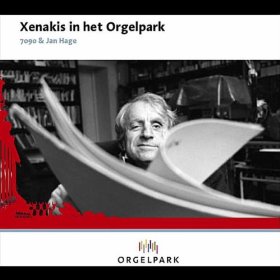Xenakis in het Orgelpark
Xenakis’s piano-brass Eonta and his organ masterpiece
View record and artist detailsRecord and Artist Details
Composer or Director: Iannis Xenakis
Genre:
Instrumental
Label: Orgelpark
Magazine Review Date: 12/2012
Media Format: CD or Download
Media Runtime: 51
Mastering:
DDD
Catalogue Number: 011-2011

Tracks:
| Composition | Artist Credit |
|---|---|
| Linaia-Agon |
Iannis Xenakis, Composer
Arne Visser, Tuba Iannis Xenakis, Composer Koen Kaptijn, Trombone Ron Schaaper, Horn |
| Eonta |
Iannis Xenakis, Composer
Bas Wiegers, Conductor Bianca Egberts, Trumpet Iannis Xenakis, Composer Jacco Groenendijk, Trumpet Koen Kaptijn, Trombone Nora Mulder, Piano Pierre Volders, Trombone Sebastiaan Kemner, Trombone |
| Gmeeoorh |
Iannis Xenakis, Composer
Iannis Xenakis, Composer Jan Hage, Organ |
Author: Philip_Clark
By thinking the organ into being an empiric source of sound, Xenakis questioned every cliché about its churchy associations. Jan Hage’s performance, startlingly close-miked, is excellent. Gmeeoorh opens with chromatic slithers that in lieu of Xenakis’s trademark glissandos – no can do on an organ – float sound through space: motifs inch forwards, slip backwards and flip to either side with the inscrutable logic of chess. When, for no apparent reason, the music drops down a black hole, it gradually re-emerges from the stillness as points on a jagged curve towards strategically placed climactic clusters. As a drone of consonant harmony drifts towards the surface, Hage simply lets the moment be, then moves on. An exploded diagram of a split-second fission stretched over 18 minutes: that’s what Gmeeoorh does.
Hage’s performance is deliberate and spacious, not words that could be convincingly applied to Eonta. A pianist friend – who has performed Eonta – tells me that Xenakis’s piano-writing is highly idealistic (nice euphemism, that). Only a mug would second-guess how precisely Nora Mulder nails Xenakis’s notes, but this music isn’t about target practice. The pianist symbolises water and the brass represent light refracting through the gaze of the sun. I’m reminded of a David Hockney splash as Mulder’s physical, alert pianism spills out against the streamlined frame provided by the brass. Linaia-Agon is, I’d say, second-tier Xenakis; no doubting this performance’s boorish splendour though.
Discover the world's largest classical music catalogue with Presto Music.

Gramophone Digital Club
- Digital Edition
- Digital Archive
- Reviews Database
- Full website access
From £8.75 / month
Subscribe
Gramophone Full Club
- Print Edition
- Digital Edition
- Digital Archive
- Reviews Database
- Full website access
From £11.00 / month
Subscribe
If you are a library, university or other organisation that would be interested in an institutional subscription to Gramophone please click here for further information.




